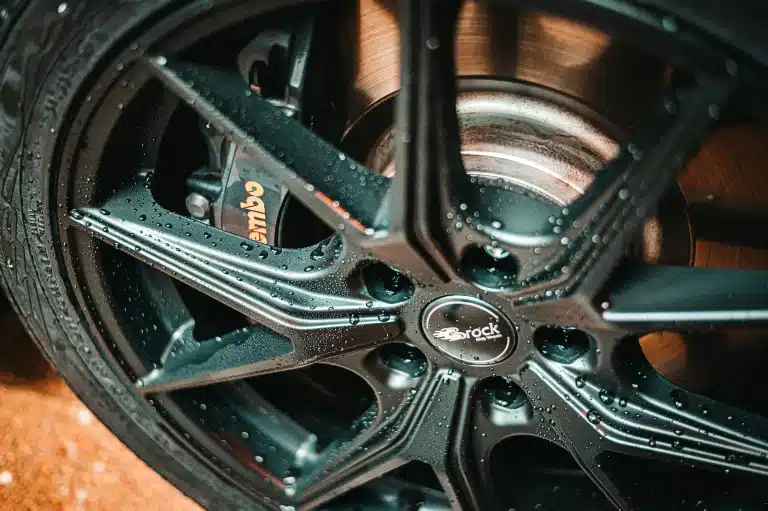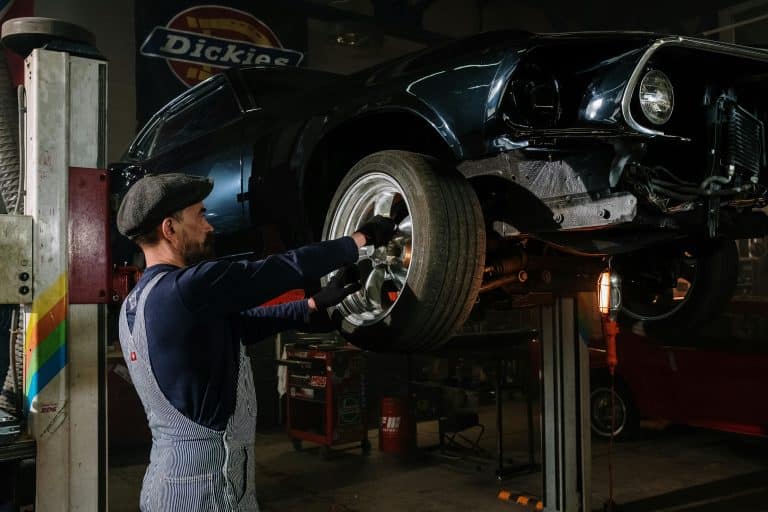If you’ve noticed car wheels that look incredibly shiny and reflective, you were probably looking at diamond-cut alloy wheels. These wheels have become popular because of their stunning, mirror-like finish. But what makes them different from regular wheels?
Understanding the Diamond Cut Process
A diamond-cut alloy wheel goes through a special machining process to create its distinctive look. The wheel is mounted onto a lathe machine, which spins it whilst a diamond-tipped cutting tool carefully removes a thin layer of material from the surface. This reveals the bright, shiny metal underneath.
If you look closely at diamond cut wheels, you’ll notice fine circular lines created by the cutting machine – these are the telltale signs of this finish. Once the cutting is complete, a clear protective coat (lacquer) is applied over the machined surface to protect it from corrosion and damage.
Diamond Cut Alloys vs Powder Coated Wheels
The diamond cut finish looks very different from powder coating. A powder-coated wheel has a dry powder applied electrostatically, then heated until it melts and forms a hard surface. According to research from the National Institutes of Health, alloy wheels play a crucial role in vehicle performance and safety.
Powder-coated wheels are extremely tough and resistant to chips and scratches. They create a thick, protective layer that handles harsh conditions well. Diamond-cut alloys are more delicate because the protective lacquer layer is thinner.
Get your free quote today
The Benefits for Car Enthusiasts
The main advantage of diamond-cut wheels is their stunning appearance. They create a bright, reflective finish that makes a car stand out. The machined surface catches light in a way that painted wheels can’t match, giving your vehicle a premium look.
Many modern cars come with this finish as standard because it’s seen as a stylish upgrade. If you take pride in your car’s appearance, diamond-cut alloy wheels can significantly enhance its overall look.
The Drawbacks to Consider
However, the diamond cut finish does have limitations. The protective lacquer can be vulnerable to damage from stones, kerbs, and everyday wear. Even small chips or scratches let water seep underneath, leading to corrosion between the lacquer and metal. This shows up as white or cloudy patches – particularly common in the UK with our wet weather and salted roads.
Diamond-cut wheels typically need refurbishment sooner than powder-coated wheels. Whilst powder coating can last many years without issues, diamond cut finishes might show deterioration within a few years, especially under harsh conditions.
Can Every Cut Wheel Be Refurbished?
Not all wheels are suitable for diamond cutting. The process involves assessing the wheel’s design and face shape. Some wheels work perfectly, whilst others aren’t compatible.
Additionally, not every cut alloy wheel can be recut multiple times. Each time a wheel is diamond cut, material is removed. After 1-2 recuts, the wheel might become too thin, compromising its safety. At this point, switching to powder coating becomes the better option.
At Alloy Fix, our technicians assess each wheel individually to determine whether the diamond cut process is possible and safe. If your wheels have been cut before, mention this so we can make the most informed decision.
How Long Does the Finish Last?
The lifespan of a diamond cut finish depends on how the car is driven, where it’s driven, and maintenance. Regular cleaning and careful driving extend the life of the finish considerably.
When properly cared for, alloy wheel refurbishment with diamond cutting can last several years. However, once the lacquer fails, you’ll need to be refurbishment again. This might involve another cut (if there’s enough material) or switching to powder coating.
At Alloy Fix, we offer a 3-year warranty on all powder coating and diamond cut wheel repairs – demonstrating our confidence in our work and materials.
Maintaining Your Diamond Cut Wheels
To get the most from your diamond cut alloys, regular maintenance is essential. Clean them frequently with appropriate products and inspect them for lacquer damage. If you spot chips or scratches, quick wheel repair prevents water from getting underneath and causing further damage.
Avoid harsh kerbs when parking and be careful of potholes. These impacts can damage both the finish and the wheel’s structure.
Final Thoughts
Diamond-cut alloy wheels offer an exceptional finish that appeals to many car enthusiasts. Understanding the diamond cut process helps you make informed decisions about your wheels. Whether you choose diamond cutting or powder coating depends on your priorities – appearance versus durability.
If you’re unsure whether your wheel is diamond cut or need professional advice about refurbishment options, contact us today. Our expert team at Alloy Fix can assess your wheels and recommend the best solution.
Frequently Asked Questions
How can I tell if my wheels are diamond cut?
Look closely at your wheels in good light. Diamond-cut wheels have fine circular lines created by the lathe machine and a bright, mirror-like reflective finish. If your wheels look very shiny with these subtle lines, they’re diamond cut.
Can diamond-cut wheels be repaired if damaged?
Yes, diamond-cut wheels can be refurbished and recut if enough material remains. Our technicians assess whether your wheel is suitable for recutting or whether powder coating would be better and more durable.
Are diamond-cut wheels worth the extra maintenance?
This depends on your priorities. If you love the look of shiny, reflective wheels and don’t mind maintenance, then yes. However, if you want something more durable and low-maintenance, powder-coated wheels might suit you better.




